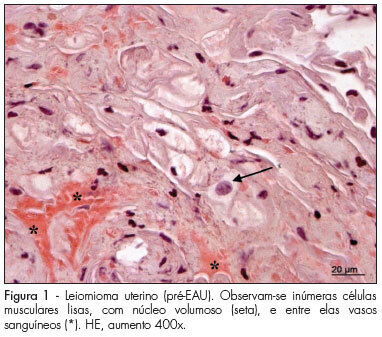You searched for:"Manoel João Batista Castello Girão"
We found (31) results for your search.Summary
Rev Bras Ginecol Obstet. 2006;28(10):596-600
DOI 10.1590/S0100-72032006001000005
PURPOSE: To analyze gestation evolution and deliveries after myoma treatment by embolization of the uterine arteries. METHODS: In the initial evaluation, 112 patients submitted to embolization of uterine arteries were included for treatment of myoma. From those, only nine wanted to be submitted to conservative treatment in order to keep their reproductive capacity. This procedure was indicated to the nine patients, since they were not susceptible to a conservative surgical treatment. They were submitted to embolization of the uterine arteries with particles of polyvinyl alcohol or embospheres with diameters ranging from 500 to 700 µm, and they have evolved without intercurrence. RESULTS: During the follow-up of these patients, there was a good clinical response with significant reduction in the uterus and myoma volumes. Four of them got pregnant, two had an early abortion and two evolved normally till the end of gestation with a term delivery. One of these had twins. CONCLUSION: Embolization of the uterine arteries is an option for the treatment of uterine myoma, and presents good clinical and anatomical results, allowing patients to preserve their reproductive capacity.
Summary
Rev Bras Ginecol Obstet. 2009;31(12):598-603
DOI 10.1590/S0100-72032009001200004
PURPOSE: to analyze histomorphometric consequences of the uterine arteries embolization (UAE) in the uterine tissue, especially by collagen tissue quantification through uterine biopsy, before and after treatment of uterine leiomyoma. METHODS: 15 patients with symptomatic leyomioma and/or infertility, submitted to UAE, participated in the study according to the study exclusion criteria, after having signed an informed consent. Uterine biopsy was performed in the secretory phase of the menstrual cycle, before and three months after the procedure, to evaluate the collagen. After the histological processing of the material, 3 µ slices were prepared, some of them dyed with hematoxiline-eosin (HE) and others with the specific dye for collagen fibers (Picrosirius red). Then, the slides were examined and interpreted, and the collagen quantified. The amount was calculated as the percent of the area composed by collagen, and the result expressed in mean±standard deviation (SD). Data has then been submitted to statistical analysis by Student's paired t test (p<0.05). RESULTS: the presence of smooth muscle cells was observed in the biopsies performed before the treatment, surrounded by a rich network of collagen fibers, which are part of the tumor, blood vessels and fibroblast nuclei. On the slides of biopsies performed after the treatment, it was observed the presence of widespread coagulation necrosis, vascular thrombosis, calcification and lymphoplasmocitary infiltration areas and clear reduction of the collagen component. The percentage of collagen fibers was higher in the pre-UAE group (84.07±1.41), than in the post-UAE (81.05±1.50) group, with p<0.0001, and 95% confidence interval (CI95%) from 2.080 to 3.827. CONCLUSION: the quantitative and qualitative collagen reduction clearly shows that the proposed treatment is efficient in reducing the tumoral mass, composed mainly by collagen fibers intermingled with neoplasic smooth muscle cells. Nevertheless, complementary studies are needed to investigate the functional and biological consequences of these histological changes.

Summary
Rev Bras Ginecol Obstet. 2000;22(10):609-613
DOI 10.1590/S0100-72032000001000002
Purpose: the effects of corticosteroids on the female urinary tract are not well understood, specially in climacteric women with or without estrogen replacement therapy. We studied the effects of corticosteroids on the blood vessels and epithelium of the bladder and urethra of female rats. Method: fifty-four female rats were used, divided into five groups. Group I - ten castrated female rats; Group II - eleven castrated female rats which receivedintraperitoneally 15 mg/kg weight prednisolone, for 26 days; Group III - twelve castrated female rats which received the same amount of corticosteroid, during the same time, and subcutaneously 10 mg/kg 17 beta-estradiol, in the last five days before they were sacrificed; Group IV - eleven castrated rats which received placebo for 26 days; and Group V - no castrated female rats which received the same dose of corticosteroid during the same time as in Group II. Results: we observed an average of 1.8 vessels in the bladder of the castrated group which received corticosteroid, a similar number to that of those which received corticosteroid and estrogen, compared with 0.8 vessel in the placebo group. Regarding the urethra, 0.7 vessel was observed in the group which received corticosteroid, as compared with 0.9 vessel in the group treated with corticosteroid associated with estrogen and 0.4 in the placebo group. Regarding the mucous membrane, the vesical epithelium thickness of 14.1 mm in the placebo group increased to 20.6 mm in that with corticosteroid and to 22.6 mm in that with corticosteroid plus estrogen. The urethral epithelium thickness of 12.4 mm in the placebo group increased to 15.1 mm in the group with corticosteroid and to 16.7 mm in that with corticosteroid plus estrogen. Conclusion: corticosteroids significantly increased the vascularization and the thickness of the vesical and urethral epithelia of castrated female rats.

Summary
Rev Bras Ginecol Obstet. 2004;26(8):613-617
DOI 10.1590/S0100-72032004000800004
OBJECTIVE: the aim of the present study was to verify whether there is a correlation between the prevalence of the polymorphism in the progesterone receptor gene named PROGINS and pelvic endometriosis at different stages. METHODS: a case-control study carried out from November 2003 to May 2004. The genotypes of 104 women were analyzed 66 women had had surgically confirmed endometriosis (26 women at stages I-II and 40 at stages III-IV), and 38 were healthy women. The 306-base pair Alu insertion polymorphism in the intron G of the progesterone receptor gene was detected by polymerase chain reaction and analyzed on 2% agarose gel stained with ethidium bromide. ANOVA analysis was performed in order to make comparisons between among the studied groups. RESULTS: the groups of women with endometriosis stages I-II (EndoI group) and stages III-IV (EndoII group) showed statistically significant increased incidence of PROGINS polymorphic allele as compared with the control group: 27% in the EndoI group, 38% in EndoII and 18% in the control group (p < 0.001. In the analyses, a high frequency of the PROGINS insertion was observed in women with endometriosis as compared to healthy women, disregarding the clinical stage of the disease (p = 0.0385). CONCLUSION: there is a significant statistical association between the PROGINS polymorphism and pelvic endometriosis.

Summary
Summary
Rev Bras Ginecol Obstet. 2003;25(10):705-709
DOI 10.1590/S0100-72032003001000002
PURPOSE: to evaluate patients who presented post-hysterectomy vaginal vault prolapse and were treated surgically by abdominal sacropexy (ASP) during the period of 1995-2000 at the São Paulo Hospital (EPM-UNIFESP). METHODS: we studied retrospectively 21 patients with post-hysterectomy vaginal vault prolapse with previous correction of cystocele and rectocele. An analysis was made taking into account the average age of the patients, number of parturitions, weight, body mass index (BMI), time between the appearance of the prolapse and the hysterectomy, duration of surgery, blood loss and recurrences. The patients underwent surgery using the abdominal sacropexy technique with or without the interposition of a synthetic prosthesis between the vaginal wall and the sacrum. RESULTS: of the patients attended in our service, 15 used the ASP technique and in one case, due to intra-operational difficulties, the Te Linde correction was used. The average age of the patients was 63.7 (47-95 years), parity of 4.6 and BMI of 26.9. ASP was performed on average 18 years after total abdominal hysterectomy and 3 years after vaginal hysterectomy. The average surgical time was 2 h and 15 min, without the need of a blood transfusion. There were no recurrences of the prolapse or preoperative symptoms (follow-up of 1-5 years). CONCLUSIONS: surgical treatment of the vaginal vault prolapse can be done by vaginal access (colpocleisis or the fixation to the sacrospinal ligament) or abdominal approach (sacropexy). The latter has the advantage of restoring the vaginal axis, preserving its depth, which apart from improving the prolapse, allows the restoration of sexual, intestinal and urinary functions (especially when associated with colpofixation - Burch). When diagnosis and treatment are adequate and the surgical team has complete knowledge of the pelvic anatomy, we can affirm that ASP reaches its objective in the treatment of vaginal vault prolapse with excellent correction and minimum morbidity.
Summary
Rev Bras Ginecol Obstet. 2021;43(11):847-852
To compare the prevalence of urinary incontinence (UI) before and during the COVID-19 quarantine in CrossFit women and their relationship with training level.
A cross-sectional study was performed among 197 women practicing CrossFit. The inclusion criteria were nulliparous women, between 18 and 45 years old, who had trained, before quarantine, in accredited gyms. The exclusion criteria were not following the COVID-19 prevention protocols and having UI on other occasions than just sport. An online questionnaire was emailed containing questions about frequency, duration, and intensity of training and data related to the COVID-19 pandemic. The participants were invited to answer whether they were infected with COVID-19 and what treatment/recommendation they have followed. Whether UI stopped among participants, they were asked about the possible reasons why this happened. The training intensity was categorized as “the same,” “decreased” or “increased.”
The mean age of the participants was 32 years old and most (98.5%) could practice CrossFit during the pandemic. There was a decrease in training intensity in 64% of the respondents. Exercises with their own body weight, such as air squat (98.2%), were the most performed. Urinary incontinence was reported by 32% of the participants before the COVID-19 pandemic, and by only 14% of them during the pandemic (odds ratio [OR]=0.32 [0.19-0.53]; p<0.01; univariate analysis). Practitioners reported that the reason possibly related to UI improvement was the reduction of training intensity and not performing doubleunder exercise.
The reduction in the intensity of CrossFit training during the COVID-19 quarantine decreased the prevalence of UI among female athletes.
